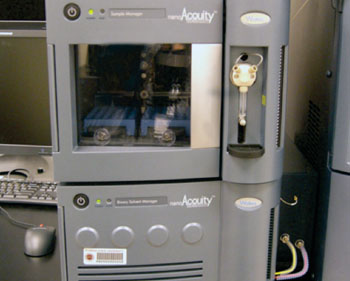Improved Mass Spectrometric Method Presented for Proteomic Analyses
By LabMedica International staff writers
Posted on 25 Mar 2014
Mass spectrometry is a highly sensitive method of measurement of cell components or body fluids that has been used for the analysis of chemical and biological materials.Posted on 25 Mar 2014
A proteome represents the entire set of proteins expressed by a cell and through analysis of proteomes, it is possible to obtain a comprehensive picture of the proteins and peptides present in cells or body fluids.

Image: The NanoACQUITY Ultra Performance Liquid Chromatograph (Photo courtesy of Waters Corporation).
Scientists at the Johannes Gutenberg University (Mainz, Germany) have optimized the mass spectrometric workflow which allows the identification and significantly quantifies more proteins than before. They have perfected a relatively new, data-independent technique that facilitates a very accurate and reproducible quantitative analysis. The team focused in particular on developing novel techniques for quantitative proteomic analysis with the aid of so-called ion mobility mass spectrometry. This technique allows not only measuring the mass of a molecule but can also determine its cross section.
The investigators have also managed to enhance the technique known as label-free quantification. This eliminates the need for samples to be labeled in the laboratory before being analyzed, an otherwise complex procedure. Liquid chromatography-ion mobility separation-mass spectrometry (LC-IMS-MS) was performed using HeLa cell lysates. A software program for the integrated analysis of measurement data called ISOQuant has also been developed. This additional analytical dimension renders the technique optimally suited for the comprehensive investigation of highly complex samples.
Nanoscale separation of tryptic peptides was performed with a nanoACQUITY Ultra Performance Liquid Chromatography (UPLC) system (Waters Corporation, Milford, MA, USA) and mass spectrometric analysis of tryptic peptides was performed using a Synapt G2-S HDMS mass spectrometer, also from Waters Corporation. The average intensity of three most intense peptides strongly correlates with the absolute amount of their source protein. ISOQuant implements the quantification method, and additionally allows user-defined approaches, varying the number of peptides used for protein quantification.
Stefan Tenzer, PhD, an immunologist and the lead author of the study said, “We are now able to directly analyze patient samples and specific immune cells without prior cost-intensive preparation.” His colleagues added that the years of work within the technology platform have paid off in terms of a quantum leap forward with regard to the improvement of the technique of proteomic analysis mass spectrometry. The study was published in the March 2014 edition of the journal Nature Methods.
Related Links:
Johannes Gutenberg University
Waters Corporation














